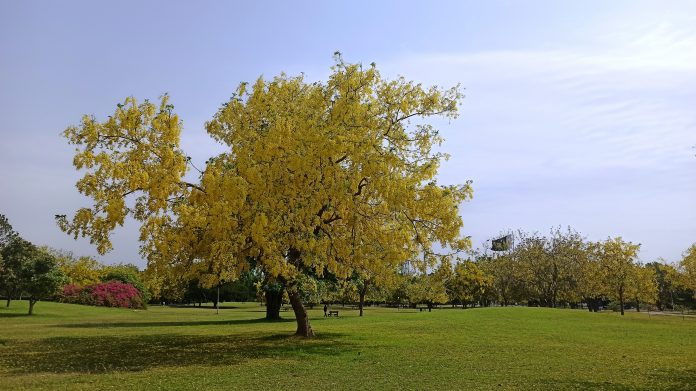The spectacular springtime show of yellow flowers gives Laburnum its common name Golden Chain Tree or golden rain. But the laburnum also has its dark side, for it is one of the most poisonous trees growing in the British Isles. Like so many of the more colorful trees that grow in Britain. This lovely tree is not native to this country. It comes from the mountainous areas of central and southern Europe and was familiar to the ancient Romans.

A great naturalist, Pliny the Elder, described it as a “tree from the Alps” with hard white wood and long yellow flowers that bees will not touch. He was right that honey bees are not attracted to this tree, because its flowers do not produce nectar. But the wood is not white; the sapwood is butter yellow and the heartwood is a dark chocolate-brown. Nevertheless, the name laburnum is derived from the Latin for white sapwood.

From its native countries, the laburnum was slowly introduced to the rest of Europe and reached Britain in the 2nd half of the 16th century. The first laburnum to be introduced to this country was the common laburnum (laburnum anagyroides). This was followed about 30 years later by another species laburnum alpinum, which was found to grow much better than the common laburnum in the harsher conditions of Scotland. Keep in mind, it is not a child-friendly tree, as all part of the Golden Chain Tree is very toxic, particularly seed pods, which highly contain cysteine, a dangerous poisonous alkaloid.

Golden Chain Tree is now known as the Scotch laburnum. A third laburnum, now more widely planted than either of the other two, is Voss’s laburnum (Laburnum x watereri). This is a hybrid between the common and the Scotch laburnum and is in many ways superior to them, particularly in its flowers. It also has a narrower crown, which makes it popular in a small garden.
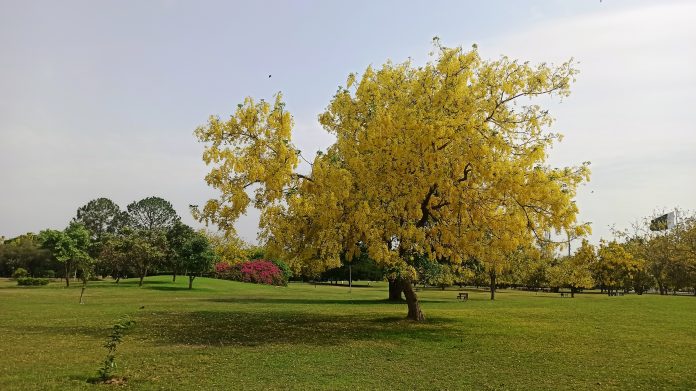
All laburnum species flourish in the British Isles; indeed, they have become adapted to the British climate better than any other introduced tree. Not surprisingly, both the common and the Scotch laburnums became naturalized soon after they were introduced helped also by the fact that both species set seeds abundantly. The best place to see a naturalized laburnum is in a wild hilly country.
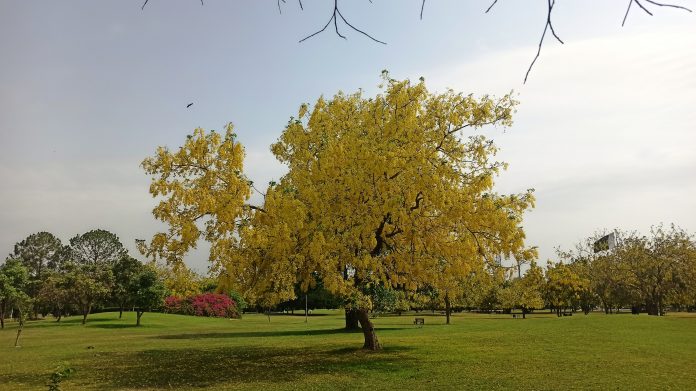
Apart from some differences, laburnums resemble each other closely. They are small trees, growing no more than 9cm high which is why they have long been popular as street trees and for planting in small town gardens. The bark is smooth and olive green sometimes turning brown with age. The trunk is slender, seldom exceeding 30cm in diameter.

Golden Chain Tree leaves are unusual in that each consists of three short-stalked leaflets. laburnum is the only tree commonly grown in the British Isles to have this leaf arrangement. The leaflets are up to 8cm long; their upper surfaces are pale green and smooth, and the lower surfaces are light grey and hairy, however hairless on the Scotch laburnum.
Moreover, the laburnum is a member of the pea family and this is shown in the shape of its flowers. These consist of five bright yellow petals arranged in typical pea fashion one large standard petal two wings and two more connected to form a keel. The flowers are borne on long pendulous racemes that vary in length from 15cm to 30cm.

On the Scotch laburnum, the racemes are a bit longer than on the common. But they are also narrower and the flowers are more widely spaced. The Scotch laburnum blooms later around the end of June, which is about three weeks after the common laburnum. The flowers of Voss’s laburnum combine the best features of the other two. Its racemes are as long as those of the Scotch laburnum, but the flowers are larger and more densely borne, like those of the common laburnum.
All plants in the pea family have their fruits borne in pods. In the case of the laburnum, these pods are slender, hairy, and light green when immature. They turn brown and lose their hair as they ripen in July and August. When the pods are ripe they twist and split along their margins, forcing out the small hard seeds these are black on the common laburnum and brown on the Scotch laburnum.
One or two seeds at the stalk end of the pod are often left behind if the twisting action was not strong enough to force them out. If the tree is growing in the wild this has the advantages of spreading out the interval at which the seeds are distributed, and so increasing the chances of a seed finding conditions favorable for germination.
Golden Chain Tree is widely planted for its beauty it is nevertheless, an extremely poisonous tree in all its parts roots, leaves, flowers, and seeds. The seeds are particularly poisonous and every year there are cases of young children falling ill after eating them. There are also a few cases of cattle being poisoned after browsing on the pods, though rabbits and hares seem to be unaffected.
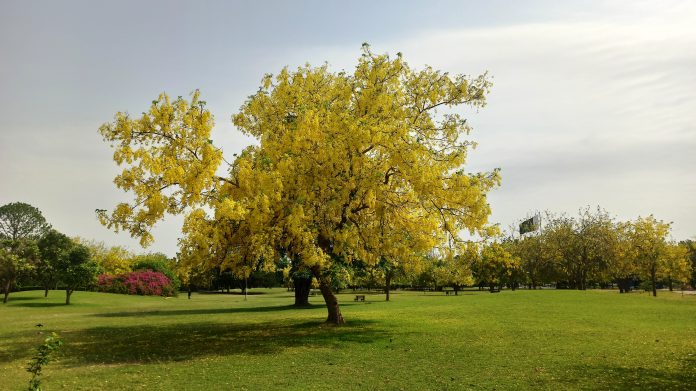
The poisonous nature of laburnums is another reason for the popularity of the hybrid Voss’s laburnum. As well as having prettier flowers than either of the other two, it produces far fewer seed pods and so attracts children less. The seeds themselves and other parts of the tree are just as poisonous as on other laburnums, however. As described above, all parts of the laburnum, especially the seeds are highly poisonous.

Symptoms appear an hour after ingestion. The victim suffers from a burning sensation in the mouth, nausea, severe thirst, abdominal pains, sweating, and headache; in severe cases, death follows. However, it is a very rare chance that children eat a lethal quantity of seeds approximately 15 to 20. Nevertheless, immediate treatment by a doctor is advisable even if only one or two have been eaten.
Over the centuries laburnum wood has been greatly prized by cabinet makers for its hardness and its contrasting colors. The difference in color between sapwood and heartwood has given rise to what is known in the furniture trade as oyster work. These are small discs or roundels of wood formed by cutting across a laburnum branch to expose concentric rings of growth.

The inner rings are chocolate brown heartwood and the 3 or 4 outer rings are butter-yellow sapwood. The tree branches can also be cut at an angle to give oval slices. Both sorts of cuts are used for decorative inlay work and veneers. Furniture carrying oyster work was particularly popular during the reign of William and Mary; today it fetches a high price at auctions. Some lepidoptera species i.e., buff-tip and Palearctic moth, used this tree as a food source.
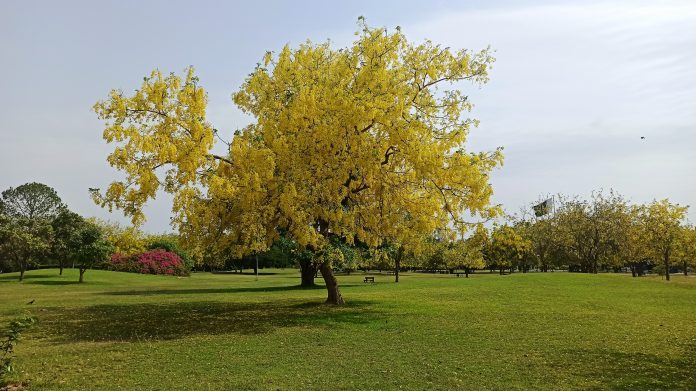
Golden Chain Tree wood is also ideal for turning work fruit bowls, egg cups, and so on since it is hard, close-grained, and takes a high polish. Pulleys and blocks made from laburnum last almost forever, and the chanters on Scottish bagpipes are frequently made from this wood because they can be bored accurately.
Young trees have weak branches, hence best to prune after each blooming season, as a preventive measure against winter damage. If you want to grow Golden Chain Tree, then select a full sun spot, well-drained soil that’s acid or alkaline (pH 5.0 to 8.0) is best. Don’t give the over water, it is highly recommended to water on a weekly basis.
